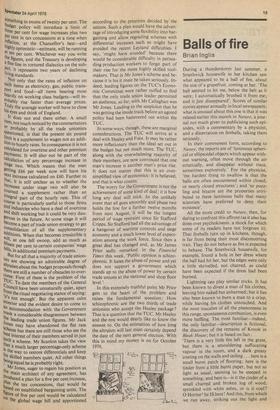Balls of fire
Brian Inglis
During a thunderstorm last summer, a Smethwick housewife in her kitchen saw what appeared to be a ball of fire, about the size of a grapefruit, coming at her. 'The ball seemed to hit me, below the belt as it were; I automatically brushed it from me; and it just disappeared'. Scores of similar stories appear annually in local newspapers; what is unusual about this one is that it was related earlier this month in Nature, a journal not much given to publicising such episodes, with a commentary by a physicist, and a dissertation on fireballs, taking them seriously.
In their commonest form, according to Nature, the reports are of 'luminous spherical or ellipsoidal objects which appear without warning, often move through the air erratically, and disappear without trace, sometimes explosively.' For the physicist, 'the hardest thing to swallow is that the balls are often encountered within closed, or nearly closed structures' ; and 'so puzzling and bizarre are the properties attributed to these luminous balls that many scientists have preferred to deny their existence'.
All the more credit to Nature, then, for daring to confront this affront (as it also has done over psychokinesis: a shock for which some of its readers have not forgiven it). That fireballs turn up in kitchens, though, is far from being their most disconcerting trait. They do not behave as fire is expected to behave. The Smethwick housewife, for example, found a hole in her dress where the ball had hit her, but the edges were only a little shrivelled, not charred, as could have been expected if the dress had been burned.
Lightning can play similar tricks. It haS been known to divest a Man of his clothes, leaving him naked but unharmed; but it has also been known to burn a man to a crisp, while leaving his clothes untouched. And the most macabre of all the phenomena in this range, spontaneous combustion, is even more baffling. The most familiar—indeed, the only familiar—description is fictional, the discovery of the remains of Krook in Bleak House; but it is based on fact :
'There is a very little fire left in the grate, but there is a smouldering suffocating vapour in the room, and a dark greasy coating on the walls and ceiling ... here is a small burnt patch of flooring; here is the tinder from a little burnt paper, but not so light as usual, seeming to be steeped in something; and here is—is it the cinder of a small charred and broken log of wood, sprinkled with white ashes, or is it coal ? 0 Horror! he IS here! And this, from which we run away, striking out the light and overturning one another into the street, is all that represents him.'
For some mysterious reason, no book has been devoted to spontaneous combustion: a gap now filled by Michael Harrison's Fire from Heaven, to be published later this month by Sidgwick and Jackson (£5.50). Harrison has amassed a formidable quantity of evidence, ancient and modern (though he has missed one recent case in Dublin); and considering the difficulties, he has made a very good case for giving the phenomenon more thought.
The difficulties arise because of the existence of a strong prejudice, not so much against spontaneous combustion 'as against the possibility that it might be a fact'. The tendency has consequently been for everybody concerned in a case, family, friends, police, coroners, judges, to prefer a natural explanation. But some of the cases presented such weird features that they were carefully documented; and it is from them that a picture can be constructed.
The human body does not burn easily; and to melt human bones requires enormous heat, around 3000°F. Yet in Florida in 1951 all that remained of Mrs Reeser, sitting in her room without a fire, were 'a charred liver attached to a piece of backbone, a skull shrunk to the size of a baseball, a foot encased in a black satin slipper but burned down to just above the ankle, and a small pile of blackened ashes'. Even in a laboratory, the body could not have been consumed by fire in that way.
In a house, the room and its contents would have gone up in flames if the heat required to melt Mrs Reeser had been introduced. But spontaneous combustion is oddly selective, not just with whatever is around at the time. The chair Mrs Reeser was sitting in had gone, and a small table, but otherwise the only sign of fire was 'a blackened circle about four feet in diameter around the remains'. With other people—and Mrs Reeser is only one of scores of cases— chairs they have been sitting in, or beds they have been lying in, have hardly been damaged. Mrs Cochrane of Falkirk was found burned to death in her bedroom in 1904, with no fire in her room, 'sitting in a chair, surrounded by pillows and cushions', though she was burned 'almost beyond recognition'. Why ?
There are few clues, but it may be worth remembering that the human body not only has the capacity to engender the immense internal heat required to melt itself in this grotesque fashion; it can also resist intense external heat. When, around a century ago, reports came in from explorers and missionaries of tribal fire-walking ceremonies, they were dismissed by James Frazer with his usual arrogant complacency as simply the result of hardening of the soles, due to the fact that the savages walked barefoot ; and there are still people who believe it is all a trick. But a great deal of research has been done into firewalking, showing that neither hardened soles nor a variety of other ingenious natural explanations can account
for the protection which the shaman, guiding his flock over the white-hot coals, manages to provide.
In many tribal communities, too, as in many early civilisations, a standard method of proving innocence has been for a suspect to plunge his hand into a boiling liquid, or to hold a red-hot iron. Is it conceivable that trials by ordeal of this kind would have been adopted, let alone would have survived, if the verdict was always and inevitably guilty ?
Fireballs, spontaneous combustion, human incombustibility. ... and these are only a few of the phenomena. Fires which burn but do not consume have endlessly been reported, from the time of the burning bush. So has luminescence—as in the haloes of the saints. It is possible, of course, that some are unrelated; at least in the sense that phosphorescence and the flame from a gaslighter are unrelated. But it seems more likely that they are all manifestations of some unexplained and as yet largely unexplored field of force. And perhaps now that Nature has put a toe in, scientists may be persuaded to take the subjects seriously, too.



































 Previous page
Previous page